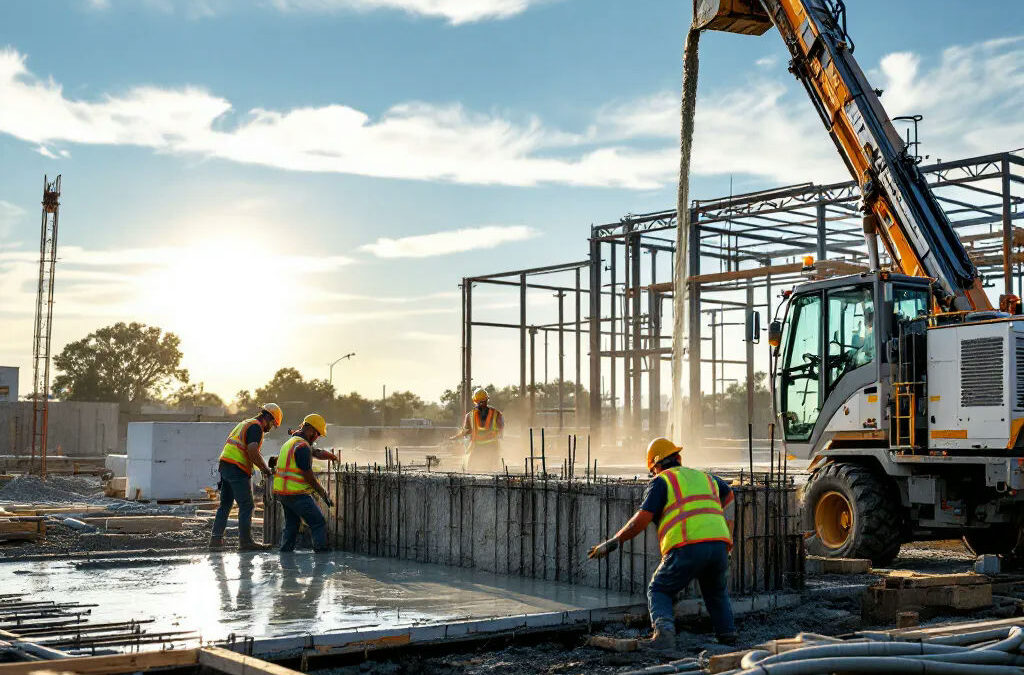Concrete is a fundamental material in the construction of commercial projects, offering unparalleled durability and strength when executed correctly. However, mistakes in concrete construction can lead to significant cost overruns and delayed timelines, impacting not only the project budget but also the overall workflow. Understanding and avoiding common pitfalls is crucial for achieving a successful outcome in any commercial concrete project.
Mistake 1: Inadequate Site Preparation
Proper site preparation is critical in ensuring the longevity and structural integrity of a concrete project. Inadequate grading and poor drainage can lead to water pooling and erosion, compromising the concrete structure over time. Additionally, neglecting soil testing can result in unforeseen challenges, such as soil instability or excessive moisture content, which negatively impacts the concrete’s performance. Conducting thorough site assessments, including soil testing and proper grading, can mitigate these risks and enhance the foundation for the project.
Learn more about what to expect during installation in this detailed guide on commercial concrete installations.
Mistake 2: Poor Concrete Mix Design
Selecting the right concrete mix design is essential for meeting the specific requirements of your project. The water-cement ratio plays a significant role in the durability and strength of the finished product; too much water can weaken the concrete, while too little can make it unworkable. Consulting with experts in mix design can provide guidance on achieving the perfect balance tailored to your project’s needs, ensuring it can withstand the demands of its intended use.
For help selecting the right mix, visit our resource on how to choose the right concrete mix.
Mistake 3: Ignoring Environmental Factors
Environmental conditions, such as temperature and humidity, can significantly affect the curing process of concrete. If these factors are not considered, the curing may be too rapid or too slow, leading to cracks and compromised structural integrity. Implementing strategies for managing weather-related challenges, such as adjusting material temperature and scheduling pours, is vital. Additionally, planning for seasonal fluctuations can help avoid these risks and promote better outcomes during the concrete curing stage.
Mistake 4: Improper Formwork Construction
Formwork plays a crucial role in shaping and supporting concrete during the curing phase. Common errors, such as inadequate bracing or poor alignment, can compromise the structural integrity of the concrete and lead to costly repairs later on. Implementing best practices in formwork construction, such as ensuring proper alignment and stability, can help produce a high-quality finished surface and protect against future failures.
Mistake 5: Inadequate Reinforcement
The structural integrity of concrete is often enhanced with steel reinforcement, which is vital for supporting loads and resisting strain. Problems can arise from the incorrect placement or sizing of rebar, leading to potential structural failures. Following guidelines for reinforcing different types of concrete structures, including using the appropriate gauge and spacing for the rebar, can ensure that the concrete not only maintains its intended design but also withstands functional demands over time.
Mistake 6: Failing to Follow Curing Protocols
Curing is a critical process that impacts the strength and durability of concrete. Rushed or inadequate curing can lead to surface cracks or weakened bonds, compromising the overall structure. Employing effective curing practices, tailored to the specific application within commercial construction, can help achieve the desired strength and longevity of the concrete. Techniques such as moisture retention methods and controlled environments can further enhance the curing process, ensuring optimal results.
Mistake 7: Neglecting Quality Control
Regular inspections throughout the construction process are vital for maintaining quality control and ensuring the concrete meets necessary standards. Employing specific tools and methods for testing concrete quality, like slump tests and air content measurements, can identify issues early in the process. Fostering open communication and accountability among teams allows for timely adjustments and reinforces a commitment to quality, preventing avoidable errors and enhancing project outcomes.
Review important safety measures for commercial concrete pours to further ensure quality and safety during your projects.
Conclusion
Avoiding these common mistakes in commercial concrete construction can save both time and money, while also ensuring a robust and reliable structure. By prioritizing careful planning, expert consultation, and adherence to best practices, project managers can greatly enhance the likelihood of success in their concrete endeavors. For more guidance on navigating these challenges or seeking professional assistance, don’t hesitate to reach out and call us at 916 562-2345 to get a quote today.


